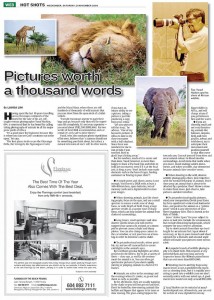Our own Mr. Yusuf Hashim aka Digitalartist is being featured in “The Star” newspaper on 19th November 2009. He gave some good tips on how to shoot wild life. It is a good read for those who wants to shoot wild life in their environment. Congratulations to you, Yusuf.
The following are quoted from “The Star” Newspaper written by Louisa Lim
Having spent the last 10 years travelling across the major continents of the world for the sake of his art, self-taught veteran photographer Yusuf Hashim, 60+, is convinced that he has found his calling taking photographs of animals in all the major game parks of Africa.
“It’s a good place for beginners because this is where you can see God’s creations out in the open,” he says.
“The best places to do so are the Okavango Delta, the Serengeti, the Ngorongoro Crater and the Masai Mara, where there are still hundreds of thousands of wild animals that you can shoot from the open deck of a Safari vehicle.
“I would encourage anyone to pack their bags and go, because only then will he experience life completely. It’s not very expensive — you need about US$2,500 (RM8,466) for two weeks of food, B&B accommodation and car rental (it’s very safe to drive there).”
Yusuf, who also conducts photo expeditions of his own, believes that “a camera should not be something you think about, but rather, a natural extension of one’s self. In other words, if you have an innate ability to see a picture, taking a picture is just like producing a copy from your retina.”
“Let your pictures tell the story,” he advises. “One of my favourite pictures of Africa to date is my close encounter with a bull elephant. Since there was nowhere for me to run or hide, I was terrified. But I’m glad I kept clicking away.”
But for newbies, much of it is easier said than done. Yusuf, however, is more than happy to share a few basic tips and tricks to help get you started, even if it is at the local zoo, as long as you “don’t include man-made elements such as the bars of cages, feeding containers or fencing in your shots”!
A simple point-and-shoot camera is not enough. You’ll need a DSLR with at least a 100-400mm lens, spare batteries, lots of memory cards and a digital wallet to store your images.
When shooting animals, just like shooting people, focus on the eyes, and use a small aperture to ensure a wide zone of sharp focus, or wide Depth of Field. Using a large aperture results in a narrow zone of sharp focus, which can help isolate the animal from cluttered surroundings.
Long lenses, small apertures and slow shutter speeds means you will need to support your camera on a tripod, or a monopod to prevent camera shake and blurry photos. You can also clamp your camera to the car window, or rest your lens on a beanbag in order to minimise camera shake.
To get professional results, where possible, try and use off-camera flash to create catchlights in the animal’s eyes.
Eyes without specular highlights are often perceived to be lifeless. Try to get a variety of shots — close ups, as well as the environment the animal is in. You can often get spectacular pictures if you shoot rapidly moving or jumping animals in a burst of 10 frames.
Animals are active in the mornings and the evenings when it’s cooler, so go out and shoot as early as possible.
In the afternoons, they are usually napping in the shade so you will not get nice pictures. Don’t be fooled by slow-moving animals like buffalo and hippos that appear to be tame or slow moving. The grass-eating hippo is the biggest killer in Africa, and will charge at you if you get between him and the water.
If you are shooting small and not very threatening animals like baboons, impalas, birds and even giraffes, zebras and wildebeest, try to anticipate their movement and position yourself so that they move towards you. Conceal yourself from view and wear natural colours to blend into the surroundings. Avoid items that rustle when you move. Avoid making sudden movements, and where possible, stay downwind because animals have sensitive noses.
When shooting in the wild, observe wildlife photography ethics. Don’t interfere with the normal behaviour of animals. Don’t shoo away an animal that is about to be attacked by a predator. Don’t throw a stone to make them move. Just observe, take pictures and don’t interfere.
To get professional quality pictures, mind your composition. Divide your frame by three equidistant vertical and horizontal lines, and position the animal on a “golden point” which is any intersection of your three imaginary lines. This is known as the Rule of Thirds.
Leave “Active Space” for your subject to move or look into. Include the environment, but exclude distracting backgrounds, which compete for your viewer’s attention.
Try to shoot animals from their eye level height for an intimate feel. Squat down if necessary, or lay on your stomach and shoot upwards for a dramatic and unusual angle which will make your pictures more memorable.
A popular branch of wildlife photography is to shoot birds. This requires a very powerful flash and very long and very expensive lenses like 800mm prime lenses that can cost more than RM50,000.
Shooting insects and tiny bugs using macro lenses is not as prohibitively expensive as shooting birds, but it is equally interesting to peek into a wildlife zone we don’t normally notice with our naked eye. A good macro lens would cost only around RM3,000.




